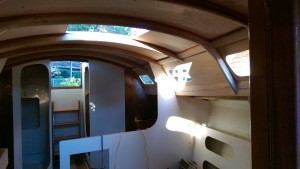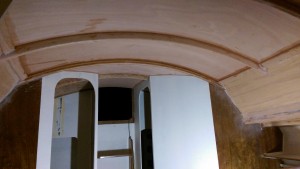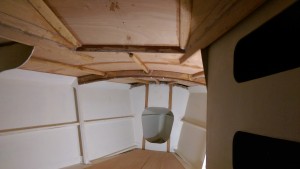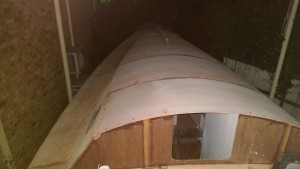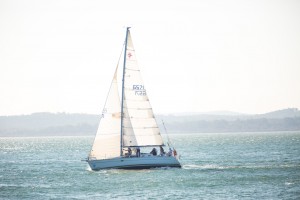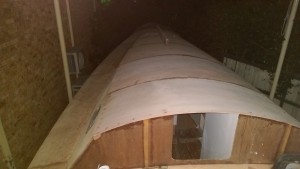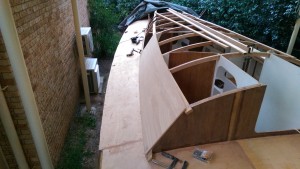Archive for May 2016
Now that the companionway access, the two deck hatches and the nine port light holes are cut there is something to show for my efforts. This morning the temperature inside the hull was down to 5 degrees C so the first task was to turn on the heater. Next in the early morning gloom I used the laser level to check the alignment of the windows. The front one is fixed by the low deck height. The rear ones can be moved around a bit because the cabin sides are taller. I made a small adjustment to make the rear one level with the one in front and set to work cutting out windows. The arrangement is quite conservative but gives a pleasant appearance particularly from the interior. Last thing tonight

Out Didi 40 cr is starting to look like a yacht now that the hatches and widows cut outs have been made.
I used some left over epoxy from reinforcing a keel floor to seal the edges of the plywood.
I have also finished the fibreglass pan under the engine area and completed bonding the engine beds to the plywood hull with 2 mm of epoxy glass so that is ready for some white epoxy primer.
One side of a keel floor has been reinforced with 2 mm of epoxy glass in an exercise that took 2 hours. Based on this time there is a week of work just glassing floors to the hull. Not all my work is on show as I have been using small windows when I cannot make a mess inside the boat to finish other areas. I have started painting the underside of the deck at the transom. It has very low headroom and it requires a bit of skill just to get to the area. As I worked my way out of the space I filled any remaining holes with epoxy bog so that it will be ready for the final clean coat of epoxy paint.
Despite the forecast of wind and rain it turned out a perfect day for gluing up the large plywood panels on the cabin roof.
The second layer of 6 mm plywood was glued in place today and I used up 6.5 kg of epoxy resin. The cabin top does not look any different with the second layer so no photos. I do have the hatches and most of the port lights so I can cut the holes for these in the next week.
I am pleased with the appearance of the cabin roof from inside the hull and the roof above the “v” berth at the front of the boat. It will soon be time to clean these up and start painting. I am keen to paint over all the bare patches where the frames were supported on the building frame and I am still debating with myself how much of the timber to varnish as features and how much to paint the same as the roof.
The long autumn has been a blessing with respect to boat building conditions and I have been able to put in a couple of ten hour days. Monday was spent installing most of the double layers of plywood under the cabin roof. These are designed to take the load of the winches and cleats and deck organisers. I wanted to glue these into place before finishing the final 6 mm plywood layer on the cabin top for several reasons. The additional two 6 mm layers of plywood fix the cabin top shape and give a solid backing to which the final layer can be screwed down and any of the screw holes from fixing the backing plates will be hidden under the final layer. I have increased the area of cabin top that has the two 6 mm plywood doublers because as well as winches and cleats I need backing for the spray dodger arches and the spray dodger track. Also we will be putting a bridle for the mainsheet controls across the cabin top and that needs a pretty substantial anchoring point. The extra weight is insignificant and I get a smooth inside of the cabin top without any stringers or visible step changes in thickness.
I am thinking of getting the Yamnar 30 hp engine delivered next week. Before putting it in the hull I have to complete an epoxy fibreglass pan inside the engine mount timbers and give it all a few coats of epoxy paint. Also on order are the hatches and portlights and the stainless steel chainplates so there will be plenty to do.
Our result last Wednesday was a thirteen place out of twenty one starters and I was happy with that result. There was really two races, one for the fleet that went for the freshening breeze on the north side of the harbour and one for the fleet that looked to avoid the tide on the south side. We beat the yachts on our side and the result was affected by the dying breeze. A dying breeze always favours the faster yachts in the division as they are home and dry before the breeze really dies. Yes I am happy that we beat Rainbow and Agrovation and Izzi and Trim across the line as these were the yachts we battled against on our side of the course.
Sunday’s West Harbour Winter Series was a similar experience only we added some extra elements of handicap. We did get a very good start and held our own to windward with the furling No 1 Genoa but we set the spinnaker from the lower halyard position when it could have gone from the masthead and when we dropped it we managed to get the rope on the furler wrapped around the base. What was surprising is that we lost not a lot of ground. With the new Passion X the lower halyard will be 350 mm higher than on Passion and the symmetric spinnaker will probable fly pretty well from the lower hoist.
Andrew Richardson from Lisdillon sent some nice photos of Passion taken at Port Stephens. The show the No 1 Genoa that we were using on Sunday and it is clear that the luff could be longer. There are also some good shots with the asymmetric spinnaker which looks strapped down a bit tight.
The first layer of 6 mm plywood on the cabin top is completed so here is a photo taken after dark. The beam on top of the cabin is a deep section of LVL which is keeping the front edge of the cabin top straight while the glue is curing on extra layers of reinforcement underneath. The extra layers of 6 mm plywood reinforcement are held on place with temporary screws from below up into the smaller strips of timber on the front of the cabin top.
After the photos I added a couple of temporary timber stringers to the cabin top on both sides of the companionway to keep the deck as straight as possible while the glue cures. I will add two layers of 6 mm plywood under the deck on each side of the companionway to take the load of winches. Once the glue on these is cured the last layer of 6 mm ply will be added over all the cabin top and then I will be able to cut out the top over the companionway. Until then it is a bit of a wriggle to get into the hull through the small opening.
Sydney has turned on some great days for boat building. Not a lot of breeze and above average temperatures makes working outside very pleasant. I hoped for more progress but the task of fitting the edge clamps to the cabin front was very tricky. As soon as that was done I started on the first 6 mm ply layer on the cabin top and by dark had glued two thirds of the first layer in place. Elaine suggested I needed a post on facebook and a blog to record the progress so here it is.
At the rate I am progressing I will need the hatches and window openings cut very soon so that I have some ventilation down below. I need six large port lights and three smaller ones. There are only two of the larger size in Australia and there is a two month wait for replacements so I will order these tomorrow.
We scored am improbable third place in the West Harbour Winter Series division 2 today. With a minimal crew we started with the anticipation of improving our handicap for the later races in the series. Off the start line it seemed that our expectations would be fulfilled. We were even more certain of a handicap improving result when we realized we had left the two big spinnakers on the dock. This was a serious seniors moment and one which left me anxious for the safety of the two spinnakers. We made do with the poled out headsail and it worked pretty well in the conditions. Most of the legs were either dead square or so tight that spinnakers were not a big advantage. The poled out headsail seemed to work much better than the assymetric spinnakers on the square legs. Consequently we had not lost a lot of time and had even gained on some Division 1 yachts that had trouble flying their assymetric spinnakers. The big move came around Goat Island where we have lots of practice on the GFS Twilight races. Here we skirted the becalmed fleet and passed all but the one that got away and finished half and hour ahead. We were kept honest by Red October in the hunt for second fastest and they did get us in the end when the breeze switched 90 degrees.
Most of the fleet in the Division 2 failed to finish or were left so far behind that our unfavorable handicap did not matter.
Just think how awesome we will be when we remember the spinnakers!!
I am varying the window layout on our new Didi 40 Cr. It will be a quite conservative arrangement but one that has been used on many production yachts. To check the visual appeal before ordering the windows I made up some mock windows from cardboard and cellophane and stuck them to the cabin sides. It was a useful exercise which resulted in me moving the positions around a little for a better look.
Friday was a big day with Kevin giving me a hand to glue in the cabin sides. There are two scarf joins in each side and these had to be glued in situ. To ensure a clean join we covered the joins with baking paper and screwed backing pieces of 12 mm plywood across the four joins. Today was a big clean up day with lots of sanding of excess glue and trimming of the excess plywood on the sides. Later today there was the final fairing of the cabin top beams and the shaping of the beam clamp at the edge of the cabin top. It is all done and I fitted a panel of 6 mm plywood to the cabin top to check all the contact surfaces. It is looking good to start the first 6 mm plywood layer on the roof on Monday.
The trip to Mexico for the Laser Masters Radial World Championships was a chance to escape from the approaching cool weather in Sydney I still have a warm glow from the experience of the sailing there and the venue would rank as one of the best I have sailed at. The closeness of the accommodation to the boat park, the quality of the food and the excellent sailing conditions all went together to make it a memorable event. It seemed that every day the breeze filled in at 1 pm local daylight saving time and we commented on being able to set the clock by the arrival of the breeze.
On Sydney Harbour today there was a pleasant warmth left over from our long summer but the breeze was anything but predictable. What breeze we had was a a small fraction of the forecast and it came from all directions. We made an excellent start on the boat end on a beam reach and managed to keep reaching up to the leaders every time the breeze faded. So fickle was the breeze in the middle ground that we passed some of the 1s fleet that had found their private zones of no wind.
We were in exceptionally good company at the top of the harbour in front of our regular competitors and alongside clubmate Agrovation but the reach back home proved to be more challenging.
Against the outgoing tide the 1 knot of wind was not helping us make much headway. We tried to pole out the genoa but the wind would not cooperate in strength or direction. We tried to poke it out to leeward but the breeze would have none of that but we found little gusts of South East breeze to keep moving back towards Steel Point. Just beyond the point the breeze switched to South West and came with some force to help us to the Rose Bay rounding mark. In the switch of the breeze Agrovation gained a few metres and went on to beat us over the line. We were left with a beat back to Point Piper to the shortened course finish at the rounding mark to record a third on handicap and a rare finish in front of the more fancied company in the fleet.
A month less one day has passed since any constructive work has been done on our Didi 40 Cr. Immediately after the Port Stephens Regatta three of the crew boarded the plane to Mexico for the Laser Masters World Championships. One of the crew was fourth in the over 75 years category. Elaine thinks they should all get a prize just for being there but the Laser cubes are strictly regulated so that they retain their value. In the 65 to 75 age group I fought it out with fellow crew member for fifth and sixth place. The number of entrants meant only four cubes for our division but fifth and sixth places are no mean feats and we are very satisfied with the results.
Jet lag has kept me subdued for a couple of days and Wednesday was the first of the RANSA Winter Wednesday races. Thursday was spent on administration matters for the GFS presentation afternoon in a couple of weeks so today was the first chance to work on the new build. I did complete the really fiddly task of installing four 50 by 25 posts to support the cabin top beams. There is no easy way to get these straight across the hull and up and down but with plenty of straight edges and clamps the job was done to my satisfaction and dinky little laminated corner reinforcements were added. All the stainless steel screws are hidden so I still have the option of varnishing the laminated roof beams. As evening falls early after daylight saving ends there was just enough time to cut our one 12 mm plywood panel for the cabin side. I scaled a development off the small lines plan and that worked our very well only needing a single trimming against the deck to get a close fit.
In the early morning before it was noise making time I reviewed all the purchases I need to make and later in the day ordered the 30 Hp Yanmar diesel and associated fittings. I have paid a deposit and the engine is on hold until complete the engine bearers. The plan is to take delivery after the bearers are installed permanently and drop the engine straight in.

